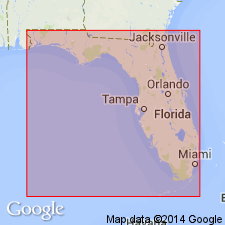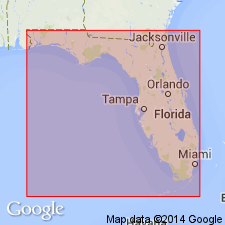
- Usage in publication:
-
- Fort Pierce formation
- Modifications:
-
- First used
- AAPG geologic province:
-
- Florida platform
Summary:
Name applied to Upper Jurassic(?) or Lower Cretaceous(?) unit. Name credited to Applin and Applin (in press).
Source: GNU records (USGS DDS-6; Reston GNULEX).

- Usage in publication:
-
- Fort Pierce Formation*
- Modifications:
-
- Named
- Dominant lithology:
-
- Shale
- Dolomite
- Limestone
- Anhydrite
- AAPG geologic province:
-
- Florida platform
Summary:
Fort Pierce Formation formally proposed. Underlies beds of early (Comanche) age and is oldest sedimentary stratigraphic unit found so far by drilling in south FL. Occurs at depths of 10,460 to 12,680 ft in type well. Age is Late Jurassic(?) or Early Cretaceous(?). [According to authors, unit contains fusulinids which are considered by some to be Late Jurassic and by others to be Early Cretaceous. It was their intent to indicate that the Fort Pierce is either Late Jurassic or Early Cretaceous, or both Late Jurassic and Early Cretaceous. Age would have been better stated as Late Jurassic and (or) Early Cretaceous.]
Source: GNU records (USGS DDS-6; Reston GNULEX).

- Usage in publication:
-
- Fort Pierce Formation*
- Modifications:
-
- Age modified
- Areal extent
- AAPG geologic province:
-
- Florida platform
Summary:
Fort Pierce Formation is Early Cretaceous [author follows age of Attilio and Blake (1983, Oil and Gas Journal, v. 81, no. 45, p. 148-153, Nov. 7), who place Fort Pierce in Coahuilan Provincial Series--oral communication, K.D. Klitgord to E.D. Koozmin, 11/93.] Geographically extended from mainland Florida into offshore shelf area of Gulf of Mexico [now called Gulf of America] of Florida and Alabama.
[Gulf of Mexico renamed Gulf of America (U.S. Board on Geographic Names per Presidential Executive Order 14172, issued January 20, 2025, and Department of Interior's Secretarial Order 3423, issued Feb. 7, 2025).]
Source: GNU records (USGS DDS-6; Reston GNULEX).
For more information, please contact Nancy Stamm, Geologic Names Committee Secretary.
Asterisk (*) indicates published by U.S. Geological Survey authors.
"No current usage" (†) implies that a name has been abandoned or has fallen into disuse. Former usage and, if known, replacement name given in parentheses ( ).
Slash (/) indicates name conflicts with nomenclatural guidelines (CSN, 1933; ACSN, 1961, 1970; NACSN, 1983, 2005, 2021). May be explained within brackets ([ ]).

